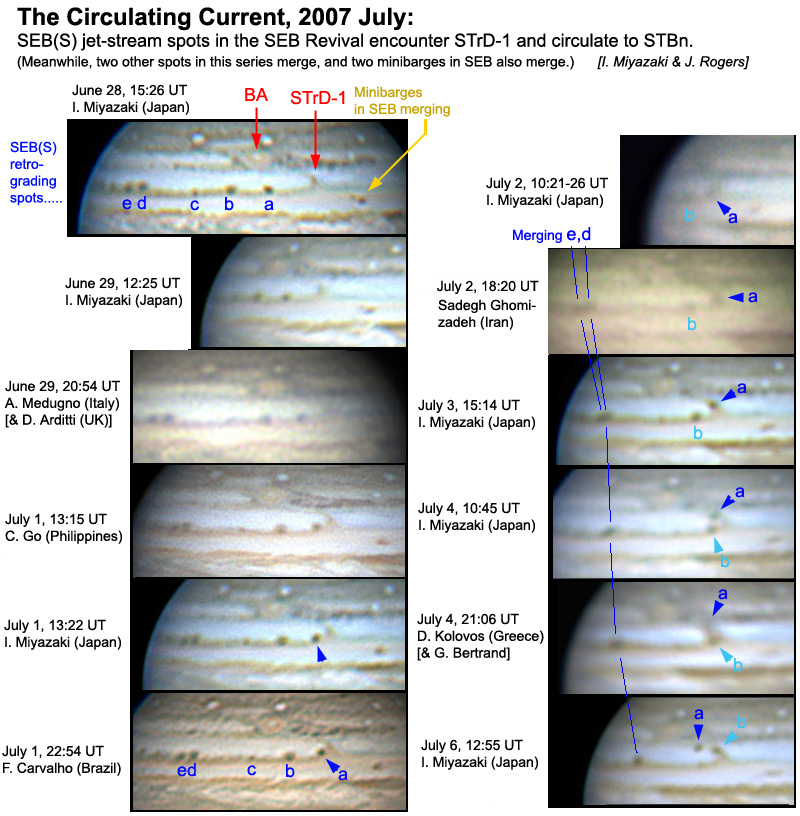[12]
SEB
revival: Circulating Current Observed! (report, 2007
July 6th)
The first of the retrograding dark
spots on the SEB(S) has indeed recirculated to the STBn jet at STrD-1, in the
first display of the
Circulating Current ever to be fully documented by imaging. The second spot is
recirculating now!
These events started on July 1 as predicted, and have been followed almost
single-handedly by Isao Miyazaki (Okinawa, Japan). This images would have
greatly delighted the old BAA observers who were the first, and last, to record
this phenomenon in the early 20th century.
The Circulating Current, at the p. side of a S. Tropical Disturbance (STrD),
transfers spots from the SEBs jetstream (westward) to the STBn jetstream
(eastward), causing them to reverse their drifts of around 4 deg/day or ~200
km/hr! This phenomenon was first recorded during the SEB Revival in 1920,
and again in 1932-34, by BAA visual observers. Those observations involved
the Great STrD, and were thoroughly described by B.M. Peek in his book. There
was no further STrD with an observable circulation until 1979 when one
fortunately arose during the Voyager 2 encounter, but the Voyager images showed
that SEB(S) spots became trapped and destroyed in the circulation, rather than
emerging onto the STBn. In 1980-81, spots did emerge p. the same STrD in
the STBn jetstream, but it was not clear if they had recirculated from SEBs.
In 1993, there was again a STrD during the SEB Revival and there was evidence
for circulation within it but no further. Thus, the present observations are the
first in the modern era to show
complete recirculation from the SEBs jetstream to the STBn jetstream.
The attached set of images shows the phenomenon in detail. (It also shows
mergers of two pairs of spots which overtook each other: two mini-barges in the
SEB, and two other dark spots in the SEB(S) chain.)

THE S.E.B. REVIVAL OUTBREAK:
Finally, a quick summary of the progress of the SEB Revival:
The southern branch consists of the dark spots retrograding on SEB(S); there is
now a long chain of them from the source up to STrD-1.
The source region, at L2 ~ 180, continues to produce bright and dark spots and
is a scene of great turbulence. Recently STrD-2, next to the course,
has darkened again.

Turbulent spots have now prograded to the Red Spot Hollow, and it was not clear
whether they would extend p. it. On June 27, images revealed were two
striking developments from this interaction: (i) a very dark rim developed on
the f. side of the Red Spot Hollow (presumably prograding dark material
reflected around the GRS); (ii) a long series of 'waves' on the SEB(N) p. the
GRS (indicating that disturbance from the SEB Revival may now be extending p.
the GRS). (See the attached image.)
The activity continues...
_________________________________
John Rogers,
Jupiter Section Director,
British Astronomical Association.

